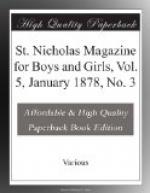Take up one of the coins and study it carefully. Every mark, letter, number and bit of decoration is deeply cut in the metal. Even the “reeding,” or roughened edge, is stamped sharply, and we can tell just what the coin is by feeling of it with the finger, even in the dark. This last step finishes the work. The money is made, coined and ready for exchange in the shop and market. Sometimes you may have noticed that coins, like the nickel five-cent and the silver twenty-cent piece, have smooth edges. In these coins the reeding is omitted. The dies in the presses have only the letters and figures of the face and back of the coin, and when the planchet is caught between them the metal is squeezed up against the smooth sides of the die, and none of the little reeding marks on the edge are formed.
“And now,” says our kind conductor, “you have seen all the process of making money. This next room is the cabinet, and here you can remain as long as you please.”
But I have not time to tell you half the curious and instructive things you may see in this apartment. There are coins of all nations and ages. Egyptian, Greek, and Roman, bearing effigies of forgotten kings and emperors; curious oblong coins, of very fine workmanship, from China and Japan, and others of a square shape with a hole in the middle, that they may be strung on a string, instead of putting them into a purse. Smallest of all, so small that you might overlook it, if your attention was not especially drawn to it, is the “widow’s mite.” Perhaps——who knows?—this may be the very coin which, dropped into the trumpet-shaped mouth of the treasury, called forth the commendation of the Savior upon the poor giver.
In other cases are the coins of England, France, Germany and other modern nations; some more beautiful than our own, others far inferior to them in design and workmanship. The cases around the wall are filled with beautiful minerals, and, in particular, many fine specimens of gold in its native state.
For so long a time have we been using paper money in this country that it seemed almost useless to have mints to make coins, when ordinary people never saw any of them, excepting those made of copper or nickel.
But our merchants, and others dealing with foreign countries, needed gold, for our paper money could not be sent to Europe, or anywhere out of the United States, to pay for goods; and so gold eagles and double-eagles and half-eagles and quarter-eagles and gold dollars were coined to be sent away, or to be used here to pay duties on imports. Silver coins also were made, to be used in foreign countries, and among these was the trade-dollar, which many of you may have seen.
[Illustration: THE COINING-PRESS.]
When silver small-change lately came into use again, there were many boys and girls who had never seen a quarter or a half dollar. When they spoke of fifty or twenty-five cents, they meant a piece of paper currency, printed like a bank-note, of no value in itself, but only a promise to pay.




